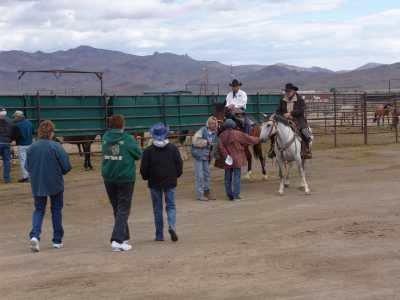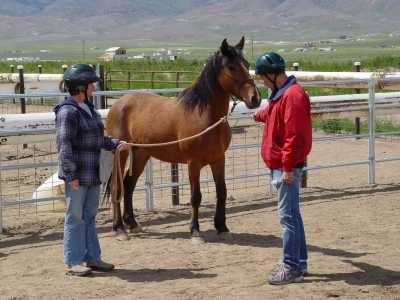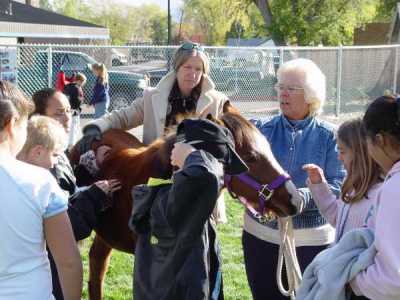|
Bills disguised as
|
|
Senator Harry Reid & Allies Attempt to Expand Wild Horse Sale Authority Part Six |
Adopters visit with wranglers and their horses
at a BLM adoption at Palomino Valley Center, NV

|
"Sorry, Senator. You can't have it both ways. If the horses are staving to death they can't reproduce at a rate to take over the range. Older horses aren't unadoptable. BLM can run an adoption program. None of your sound bites passes muster." Willis Lamm, LRTC Wild Horse Mentors
One of the frustrations common to people who work long term with wild horses and on wild horse issues is the ease by which some politicians, particularly Harry Reid, will rail upon BLM in order to get cheap sound bites. Reid and others claim that BLM is holding thousands of unadoptable horses, that BLM isn't capable of running an adoption program and that their latest laws are necessary to either protect the thousands of starving wild horses, or control the thousands of wild horses that are so rapidly reproducing that they are taking over the range, depending upon the audience to which they are speaking. In fact some of the more cumbersome elements that complicate BLM's adoption program involve requirements within laws created by Congress. Furthermore, what would motivate BLM personnel to get creative and try to produce better results when no matter what they do certain politicians will use the agency as a convenient whipping boy in order to drum up support for whatever wild horse scheme they are currently trying to advance? BLM certainly isn't perfect, however the people who work for the agency deserve credit when they do something right and criticism should be focused on specific areas that need improvement over which the agency actually has control. Wild Horse Groups Will Support Rational Solutions There are three fundamental areas within the greater wild horse issue; range management practices, holding facility inventory, and quality of adoptions. While not all of the various wild horse groups specifically agree on every point, a generally accepted platform is as follows.
|

Instead of designing "fire sales" that are likely to benefit only a few individuals and, in some cases, foreign corporations, politicians seriously interested in making the most of BLM's Adopt-a-Wild Horse or Burro Program should consider the following strategies.
In other words - Create things that make adoptions more successful for adopters and their animals. Positive results will consequently follow. Some of these strategies will require capital investment. Most BLM facilities are not currently designed to facilitate significant adopter education programs. The National Wild Horse and Burro Interpretive Center has yet to be funded. However it is these kinds of activities that will produce long term results in producing better prepared adopters and improvements in both the quantity and quality of adoptions. Considering that public lands ranching costs the taxpayers approximately a half billion dollars a year, a few million spent to enhance the adoption program and support local agricultural economies is not an unreasonable expenditure. Senator Reid has described Nevada as having the majority of the wild horse "problem." Perhaps the Senator is the problem. Nevada's wild horses are a resource treasured by countless citizens. The "wild horse" quarter design drew the greatest support from several very artistic choices. In a recent on-line poll conducted by the Nevada Appeal over 83% of respondents rejected Senator Reid's proposed bill. Perhaps the Senator needs to come out of isolated Searchlight once in a while and see what the majority of Nevadans think about his wild horse policy. Nevada's wild horses are a valuable resource. They are part of what makes Nevada what it is. They attract tourists. Established science suggests that they have little negative impact on the range, particularly when compared with the impact of public lands ranching. Their numbers are managed. Adopted horses contribute to Nevada's changing agricultural economy. It is time for Senator Reid and his compadres to wake up and smell the horses, and if compelled to produce some wild horse legislation, then write a sensible law that truly does protect wild horses and that which all parties of interest can respect.
Return to Part FiveReturn to the BeginningView the Carson City Protest & Press Conference Album
Return to KBR Wild Horse and Burro NewsReturn to KBR World of Wild Horses & BurrosGo to other Wild Horse LinksGo To
|
 In 2000 an informal survey was taken of successful adopters who were involved with the Wild Horse Mentoring Program. Volunteers determined that each family unit that had a successful and fulfilling first adoption acquired an average of 3.6 animals over a five year period.
In 2000 an informal survey was taken of successful adopters who were involved with the Wild Horse Mentoring Program. Volunteers determined that each family unit that had a successful and fulfilling first adoption acquired an average of 3.6 animals over a five year period.